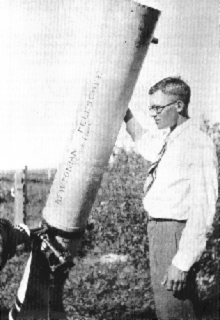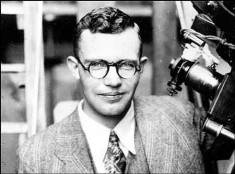| Clyde Tombaugh | |
|---|---|
 |
|
| Astronomer | |
| Specialty | Discovery of Pluto |
| Born | February 4, 1906 in a ranch near Streator, Illinois, U.S. |
| Died | Jan. 17, 1997 (at age 90) Las Cruces, New Mexico, U.S. |
| Nationality | American |
Clyde Tombaugh was an astronomer from the United States. He is most famous for being the man who discovered Pluto, which for many years was considered one of the nine major planets of the solar system, but which after Tombaugh’s death was reclassified as a dwarf planet. This was the first Kuiper Belt Object to be discovered. Tombaugh was also active in hunting for asteroids and discovered a considerable number of them. More controversially, he was a supporter of UFO research, which he believed should be carried out on a formal, scientific basis.
Early Life and Education
Tombaugh was born on a ranch near the Illinois town of Streator on February 4, 1906. He went to Streator itself in order to attend high school, but then moved to the west of Kansas along with his family. He was hoping to go to college with money gained from income from the family’s crops, but a severe hailstorm halted that idea.
Instead, Tombaugh continued to study at home, learning trigonometry and solid geometry from books. In 1926, only 20 years old, he constructed his first telescope. He did not consider it to be a success and decided that he needed to learn more about optics. Over the next couple of years, he built two further telescopes, even grinding the glass for the mirrors and lenses himself.
Interest in Astronomy
Tombaugh used the best of these homemade telescopes to observe the planets, in particular Mars and Jupiter. He made detailed drawings of the bodies, and sent them for analysis to Flagstaff, Arizona, the home of the prestigious Lowell Observatory. The astronomers there quickly realized that the young man from Kansas was in possession of impressive observational abilities, and in due course an invitation arrived for Tombaugh to come to the Observatory himself to carry out more advanced work. He accepted the invitation, and remained at Lowell for almost a decade and a half.
Discovering Pluto
In 1930, Tombaugh achieved what many astronomers before him had tried and failed to do: he discovered a new planet orbiting beyond Neptune. The existence of such an object – often referred to simply as “Planet X” – had been assumed for many years, because of inconsistencies in the orbit of Neptune, but it was Tombaugh who made the breakthrough.
 On February 18, 1930, he realized that a point of light had moved between the images on two photographic plates of the same area of the sky. Once he had eliminated the possibility that the moving speck could be a comet, meteor, or even a speck of dust on the camera lens, his discovery was announced.
On February 18, 1930, he realized that a point of light had moved between the images on two photographic plates of the same area of the sky. Once he had eliminated the possibility that the moving speck could be a comet, meteor, or even a speck of dust on the camera lens, his discovery was announced.
Tombaugh became something of a celebrity as the only living person to have found a planet – at that time, no planets were known outside our own solar system – but he continued to work professionally. He moved to the University of Kansas in 1932, and four years later he earned a bachelor’s degree in science. Although the observatory at Kansas was rather small, he was able to carry on with his studies at Lowell each summer while he was studying. Once he had graduated, he went back to the Lowell Observatory on a full-time basis. The University of Kansas awarded him a master’s degree in 1938.
Other Work and Later Life
Tombaugh remained at Lowell for several more years, during which time he discovered many hundreds of new celestial bodies. These included two comets, a large number of previously unknown variable stars, and several hundred asteroids. He also pinpointed the locations of several star and galaxy clusters, and noted almost 30,000 galaxies in all. When World War 2 broke out, Tombaugh was called up into the U.S. Navy, where he used his scientific background to serve as a navigation tutor at Arizona State College. In this role, teaching naval recruits the basics of this vital skill at sea, he served from 1943 to 1945.
Lowell did not call upon Tombaugh to return after the war because of a lack of funds, so the astronomer instead went to work on ballistics research at White Sands in New Mexico. Here, he oversaw the development of optics used for missile testing. He also designed a number of instruments of his own, including a high-specification camera that remained the best of its type for over a quarter of a century.
He left White Sands in 1955 and joined the faculty of New Mexico State University, giving lectures across North America to raise money for a scholarship fund set up in his name. He died at the age of 90 on January 17, 1997.